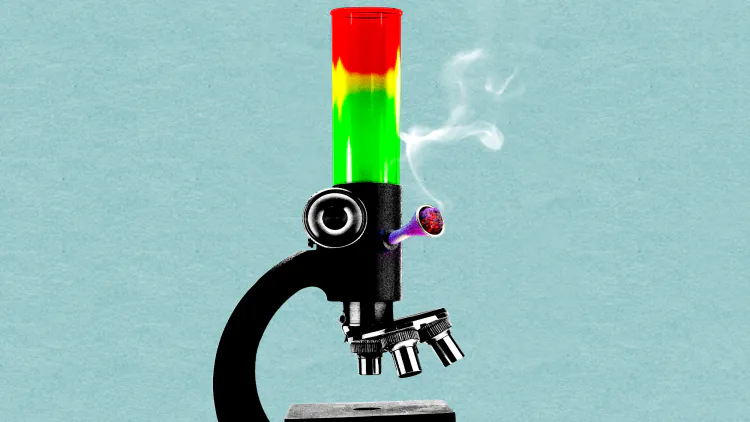Marijuana’s Health Effects Are About to Get a Whole Lot Clearer
Rescheduling weed will clear the way for scientists to study it more directly.

Earlier this week, news leaked of the biggest change in federal drug policy in more than half a century. The Associated Press reported—and the Department of Justice later confirmed—that the Drug Enforcement Administration plans to recategorize marijuana under the Controlled Substances Act. Since the 1970s, it’s been placed in Schedule I, a highly controlled group that includes drugs like heroin, with a high potential for abuse and no medical use. But cannabis will soon be moved to the much less restrictive Schedule III, which includes prescription drugs such as ketamine and Tylenol with codeine that have a moderate-to-low risk of addiction.
Currently, recreational cannabis is legal for adults over the age of 21 in 24 states, which are home to more than half of the U.S. population. According to a recent Harris poll, about 40 percent of Americans use cannabis, and a quarter do so on at least a weekly basis. And yet, researchers and physicians told me, scientific consensus on the drug’s precise effects—especially on the heart and lungs, mental health, and developing adolescent brains—is still lacking. Rescheduling marijuana will broaden access further still, which makes finding better answers to those questions even more crucial.
Conveniently, rescheduling marijuana is also likely to spur in-depth study, in part by expanding research opportunities that were previously limited or nonexistent. Easing restrictions will ultimately mean learning a lot more about the potential harms and benefits of a drug that for decades has been both popular and demonized.
Historically, the scope of cannabis research has been fairly limited. The National Institute on Drug Abuse, a major federal research funder, has a directive to study the harms of cannabis use rather than any potential benefits, says Amanda Reiman, the chief knowledge officer of New Frontier Data. (New Frontier is an analytics firm focused on the legal cannabis industry.) In 2018, research on the potential harms of cannabis use received more than double the funding that research on its medicinal or therapeutic use did in the U.S., U.K., and Canada. In 2020, a spokesperson for NIDA told Science that although the agency’s traditional focus was on marijuana addiction, it has started exploring the therapeutic potential of compounds in cannabis to treat addiction to other substances.
U.S. policy has also made marijuana research of any sort very difficult. Until recently, scientists had to obtain their supply from NIDA’s high-security Mississippi facility. (Six more sources were approved last year.) Researchers regularly complained that the marijuana was moldy, and far from the quality that regular consumers could purchase legally at their local dispensary, with less THC and CBD.
[Read: The government’s weed is terrible]
Most existing research on how cannabis affects our hearts, our brains, and our society at large is based on self-reported survey data, Peter Grinspoon, a physician at Massachusetts General Hospital and a medical-cannabis expert, told me. Such data are “notoriously inaccurate,” he said. But researchers have been forced to rely on these methods because cannabis is a Schedule I drug, so no studies that receive federal funding can simply give marijuana from state-approved dispensaries to people and record what happens.
As a result, the field lacks the number of high-quality studies necessary for researchers to agree on their implications, says Nick Cioe, an associate professor at Assumption University in Massachusetts who has studied the effects of marijuana on traumatic brain injuries. Randomized controlled trials are the gold standard of determining a given drug’s harms and benefits, but for weed, they’ve been nearly impossible. The FDA has approved a handful of cannabis-derived products to treat conditions such as seizures and chemotherapy-induced nausea, but that’s not the same as understanding the effects of recreational weed.
After marijuana is officially rescheduled, researchers will have a far easier time studying the drug’s effects. Researching any federally controlled substance is difficult, but obtaining the proper licenses for using Schedule III drugs in the lab is much less arduous than for Schedule I. Scientists will also have far more opportunities to obtain federal grant funding from all sorts of governmental bodies—the National Institutes of Health, the EPA, even the National Highway Traffic Safety Administration—as policy makers rush to understand the implications of legalization.
Human trials won’t start the second that the DEA makes marijuana’s new status official. Researchers will have to wait for guidance from federal agencies like the FDA and the NIH, says R. Lorraine Collins, the director of the University at Buffalo’s Center for Cannabis and Cannabinoid Research. And given the limitations around Schedule III drugs, scientists still won’t be able to simply purchase the same cannabis that millions of Americans are consuming from their local dispensary.
[Read: Almost no one is happy with legal weed]
Schedule III won’t “magically alleviate the bureaucratic headaches” associated with researching cannabis, Grinspoon said. But “it’s going to be a lot easier to say, ‘Let’s give this person cannabis and see what happens to their blood pressure.’”
What's Your Reaction?




















